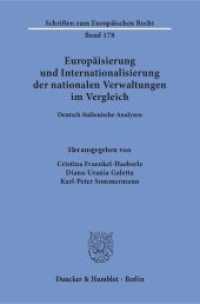- ホーム
- > 洋書
- > 英文書
- > Business / Economics
Full Description
The Routledge Handbook of Tea Tourism provides comprehensive and cutting-edge insights into global tea tourism. With contributions from leading scholars and experts across 19 countries, it demonstrates the interdisciplinary nature and breadth of topics associated with global tea tourism.
Tea is deeply connected to tourism through both travel and consumption. For host communities it provides an opportunity for diversification from the production and/or serving of tea while sharing cultural traditions and improving livelihoods. The Handbook is organised into five parts, with an introduction and epilogue, and the first part begins with an overview of historical and contemporary perspectives on the foundations of tea tourism. It digs into the roots of such tourism in China, the relationship of wild tea to indigenous tourism in Vietnam, heritage railways to tea tourism, and tea tourism in Africa. The second part examines sustainable tea tourism, with examples from Thailand, Turkey, Sri Lanka and India. The third part explores the management and marketing of tea tourism, highlighting tools and techniques for development and the impact of social media on the tea tourism experience. It draws on examples of tea tourism experience in diverse settings, such as the English tea room, a pearl milk tourism factory in Taiwan and a hot spring tea destination in Japan. The fourth part provides perspectives on innovation and practice in tea tourism, such as gastronomical tea tourism in Turkey, Japan and Thailand; tea cafés and community diversification in Japan; the role of GIAHS designation in tea tourism; and tea tour guiding in Iran. Finally, the fifth part provides insights on resilience in tea tourism, examining topics such as human-wildlife conflicts and the impact of the COVID-19 pandemic on the sector in both Asia and Europe.
This Handbook provides a valuable resource for students and researchers, presenting a rich collection of theoretical and empirical insights, an agenda for future directions in the field and end-of-chapter discussion questions. It also serves as a useful tool for key stakeholders, aiming to increase interaction between academia and industry, encouraging the development of sustainable responsible tea tourism that benefits local communities on a global basis.
Contents
Introduction
PART I
Foundations of tea tourism
Ancient origins of tea tourism
Tea tourism and route heritage: Nakeli village on China's Ancient Tea Horse Road
Tea and spiritual travel: Panchen Tuo tea
Wild tea and indigenous tourism: a case from Vietnam
The heritage railway and tea tourism: The case of Senzu, Japan
Cultural heritage and tourism: Friesland tea
Recognition of the cultural heritage of tea: An international perspective
Teaics as a knowledge resource for tea tourism
Tea tourism in the global south: An African perspective
PART II
Sustainability in tea tourism
Integrated management of community-based tea tourism: Value through symbiosis
Tea community culture and tourism: The case of Turkey
Hospitality and tea: Taking tea culture to the next level
Homestay in small tea gardens: The case of Meghalaya, India
Line rooms: An authentic approach to heritage tea tourism
Employment issues in tea tourism: A way forward
Part III
Management and marketing of tea tourism
Service quality in an English tea room: A picture is worth a thousand words
Tea factory tourism experiences: Pearl milk tea in Taiwan
Facilitating tea stories on Instagram during the COVID-19 pandemic
Cultivating sense of place: Sabah tea experience in Malaysian Borneo
Perceptions of tea tourism value and its impact on destination attractiveness
Revitalizing a region using tea tourism: The case of Umegashima, Japan
Linking tea, tourism, and community using Porter's Diamond model
Marketing Green Tea Tourism Destinations
PART IV
Innovation and practice in tea tourism
Gastronomy and tea tourism: Tea-oriented gastronomy tours in Rize, Turkey
International exchanges and gastronomical tea tourism
Tea cafés and community diversification
Tea tourism promotion in Globally Important Agricultural Heritage Systems (GIAHS)
Exploring the value creation process in the Japanese black tea market and tourism
Tea tourism and tea tour guiding: The case of Iran
PART V
Resilience in tea tourism
Resilience through tea tourism: a tea region case from India
Human wildlife interactions in tea tourism: the Dooars in India
A resilient tea destination: the Azores archipelago
Epilogue







